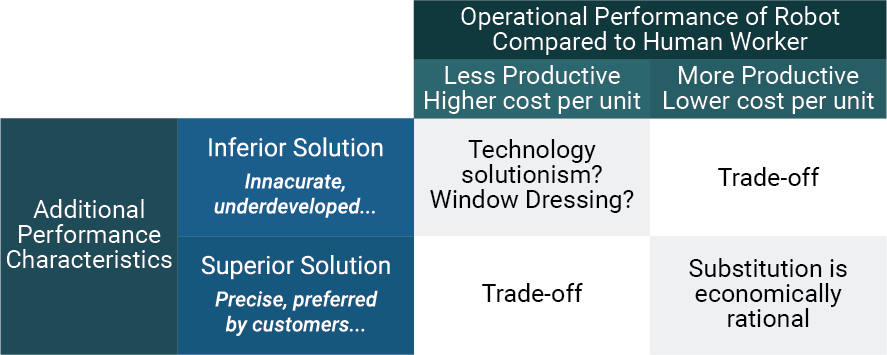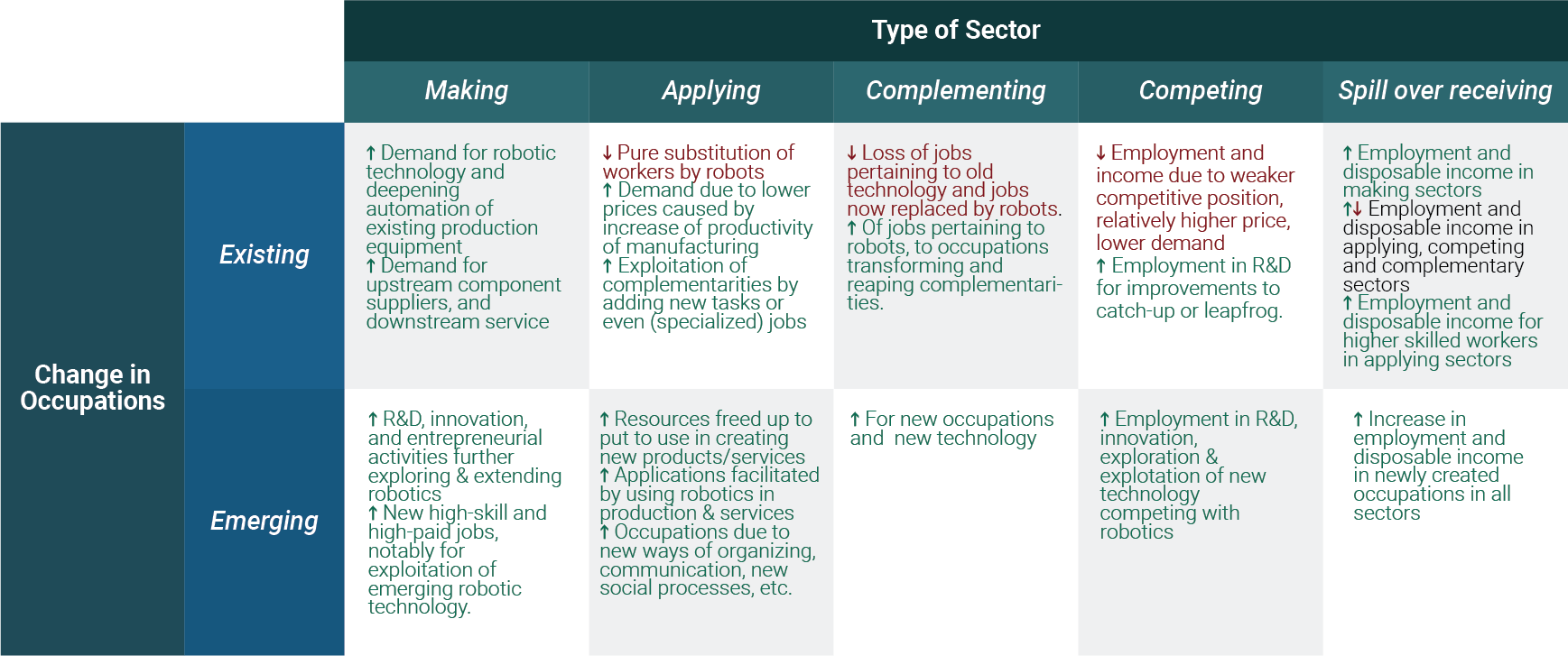Economics of Robotization
On a large-scale, what comes after the introduction of a robot?

The last couple of years, inventions in artificial intelligence (A.I.), electromechanical actuators and batteries have made robots more nimble, smart, and versatile. With that, the number of applications of robots and the number of sectors thus actually using, or able to use, robots have increased. In fact, robotics may well be a new general-purpose technology (Lipsey, Carlaw & Bekar, 2006) that will change the global economy and possibly society at large.
Here, we take a comprehensive view on the economics of robotization. Addressing mainly the macro-level rationales and impact of robotization, but acknowledging that there are potentially far-reaching consequences for individuals.
Firm Rationales for Robotization
Cost Competitive Pressures and Production Rationalization
There are multiple reasons why firms acquire robots (or develop them in-house) for application in their own production processes:
- Robots may be part of process innovation to increase the productivity, reduce dependency on human labor, lower unit cost, differenciate products from those of competitors, etc.
- Robots may (help to) provide new services and enhance services readily provided to customers that are complementary to the products.
- Firms may seek to enhance and bolster their reputation as engaged in advanced technology.
- The (supposed) sake of workers, or because robots may be more precise, can work in harsh conditions, or may be risked.
From a competitive point-of-view, firms mostly introduce robots to increase productivity (lower unit cost, higher efficiency). Of course, this does not mean all robots increase productivity. Even if the total cost of ownership of robots exceeds the cost of labor, robots are introduced if they are believed to yield a sufficiently higher productivity and thereby lower unit costs, or whenever robots yield more competitive products or services (e.g. in terms of quality) and thereby a sufficiently higher revenue. As such, there are situations in which robotization is a trade-off.

Rationality of robotization in a two-dimentional performance framework. When the operational performance in terms of unit cost is pitted against another performance characteristic.
Impact on Workers
Over the past centuries, there have been several waves of innovations that enhanced the productivity of laborers. Generally, processes of mechanization, automation, and computerization increased the agricultural yield per farmer per acre, the number of products produced per worker per hour, or the value added per worker per task. As mentioned in Meaningful Work, there are several potential effects for individual workers in workplaces adopting the productivity-enhancing, labor saving technologies:
- Higher productivity per worker means that fewer workers are needed for the same output.
- With the introduction of technology, the sets of tasks executed by workers may change.
- Given the change in task sets and required skills, the wage of workers may change.
- Newly unemployed may look for jobs in the same sector or (may be forced to) look for jobs in other sector(s) that may require different skils.

Expand the tabs below to read more.
Much of the popular debate focuses on which jobs will be robotized and what happens with the total rate of employment. Until recently, the labor economic literature concerned with technological change argued that particularly low-skill jobs would be at risk of mechanization, automation, and now robotization.
Nowadays, though, it is argued that technological substitution primarily occurs for routinized tasks in stationary, predictable environments. Jobs which require refined perception and physical dexterity, creative intelligence/ improvisation, or social intelligence, regardless of whether they are low-skilled or not, are less at risk of replacement (Brynjolfsson, & McAfee 2011; Deming 2015; Frey & Osborne 2017).
While robots may take over human jobs entirely, it is more likely that robots perform certain tasks, and that workers get an altered set of tasks.
Indeed, the introduction of robots in the workplace may have a great impact on the tasks executed and skills required. It may well be that workers get new tasks assigned that are complementary to the tasks of robots. These tasks may be more complex and require upskilling, but this is not necessarily so.
A primary concern of mechanization, automation, robotization, etc. is that it widens the gap between the rich and poor. Given that routinized tasks are more prone to be taken over by robots, certain jobs are more likely to be affected and possibly vanish completely. Due to predispositions and personal aptitudes, those newly unemployed may be struggling to re- or upskill themselves to compete for other jobs and face an increasing pool of low- and middle-skilled unemployed competing for scarce low-skill jobs. So, due to limited geographical and labor mobility as well as increasing competition for jobs, we may see an increasing class of people grappling for a low income.
These stratifying and polarizing forces also work across the globe. Given differences in the sectoral and occupational composition of economies, the impact of robotization may greatly differ across nations and effectively exacerbate the ‘North-South divide’.
Structural Change
Multi-Sectoral Perspective on the Impact of Robotization
Here we provide a comprehensive overview of the effects of robotization, both in terms of employment and income specified for the different types of sector.

Labor Mobility & Vacancy Chains
Labor mobility is paramount in sustaining high levels of employment. After all, workers need to be able to acquire skills complementary to working with robots in the applying sectors, or workers laid off may need to re- or upskill to find work elsewhere in the same or another (applying) sector.

Policy Interventions
As outlined above, the progressive adoption of robots, if occurring, might have several fundamental consequences in terms of employment, income, and opportunities. However, so far, the role of governments has not been explicitly considered. Governments have several instruments at their disposal to regulate the adoption of robots and/or mitigate the impact thereof. There seem to be three main types of interventions:
- Impose a tax on robots / robotization
- Provide an unconditional income, or Universal Basic Income
- Catering to the shifts in labor demand
- General-Purpose Technology: Technology with applications in many sectors, a major impact on economic growth, and transforming society. Examples are smelting of ore, writing, the steam engine, electricity, the computer, the internet
- Production Rationalization: Increasing the efficiency of an existing production process by changing the division of labor, redefining production steps, and introducing alternative process technology (such as robots).
- Rehumanization Argument: Line of reasoning arguing in favor of progressive robotization because robots can and may take over dull, dirty, and dangerous work, deemed ungratifying and thus free humans that can then focus on work and requiring supposedly distinctly human qualities. Robotization thus facilitates rehumanizing work of people to do supposedly gratifying, meaningful work rather than supposedly ungratifying meaningless rationalized production activities.
- Quality-Meaning Fallacy: The (possibly) mistaken belief that jobs requiring more human qualities (notably social skills, creativity, intellect) are considered more meaningful or desirable to or more appreciated by workers.
- Inclusive Growth: A central policy objective of the European Union emphasizing that all classes of society across all nations should benefit from economic growth
- Structural Change: An economic core concept on how the composition of an economy evolves over time in terms of sectors and occupations, often due to cascading effects of development and application of new technologies
- Dinamic Efficiency & Innovation Policy: An economic growth policy, proposed to facilitate creation of an efficient reallocation of labor across occupations and sectors.
Key Concepts
Reflection Points
- When thinking of robotization, how to assess the economic impact on current working processes?
- How do you think you will be able to reskill if robots are introduced in your work?
- What do you think will be the impact of robotization in your daily life?
- Do you think structural change will affect you?
Concluding Remarks on Economics of Robotization
Here we provided a comprehensive introduction on the economics of robotization, including: the rationales for robotization, impacts of robotization including impact on workers and structural change, and some of the proposed or emerging policy interventions in response to robotization.We opened with a discussion of what drives firms to adopt and develop robots. Followed by an analysis of the expected effects of robotization for workers and the potential structural changes to the economy in terms of employment. We aimed at raising awareness about the potential effects of robotization.
If you found this interesting, read more here:
Click here to Download Chapter 9: Economics of Robotization
Download
If you enjoyed reading about Economics of Robotization, you may also like:
By going over each icon with the mouse you will get a brief description of the corresponding topic.